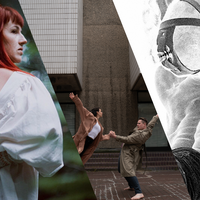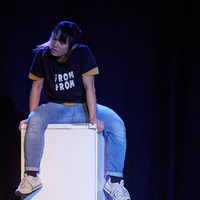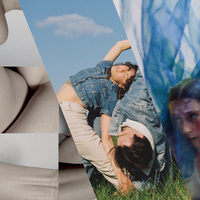Wed 31 Jan: Aimée Ruhinda, Emma Skyum and Lizzy Tan

News Story
Aimée Ruhinda A Good Scare is a wonderful Aphrodisiac
Emma SkyumLEUCA
Lizzy Tan Revolver
We enter the theatre into a new world, a technological space with a projection on loop that interrogates us, the audience. When it begins, choreographer/performer Lizzy Tan dances alone on stage, before being joined by images of the past, moving footage that resonates with the dancing just performed. As time goes on, we delve deeper into this archive, the psyche of a decade’s worth of dance works layered and interconnected like an intricate web. Revolver, a futuristic dance installation, an archive of archives within digital duet partners leaves us with many questions. What do we remember? How do we remember? What is ours to remember?
An articulate body, nude costuming, a figure on display. Powerful bright lights leave nowhere to hide. Emma Skyum’sLEUCAL juggled sculptural moments, a clear movement language and a high-paced soundscape that kept the intensity of its atmosphere at a constant high. Built on a choreographic style that echoes Graham and Gaga, stillness was as powerful a tool as the shapes performed, a successful exploration of the minimalism behind the work. But as the intensity of the air seemed at odds with the happenings on stage, perhaps a drastic change of pace would have offered something new, a welcomed chance to reengage the audience.
A Good Scare is a Wonderful Aphrodisiac is a rare ensemble piece for Resolution’s frequent solos and duets. In a land of corsets and lace, there is nothing delicate about Aimée Ruhinda’s work, a fresh and aggressive take on feminist empowerment. Under the witch archetype, the coven of six performers moves through choreography that is strange, sultry, scared and scary, with an equally eerie soundtrack, like that out of a horror film. To make a dance piece a successful psychological thriller is no small feat, for which congratulations are in order. And yet, as the ritualistic took over for the piece’s conclusion, to see these characters lose all control would have been a wonderful treat – restraint was not needed here.
Sara Silva
Lizzy Tan’s Revolver engages with their own process of making. When a projected Avatar of Tan flickers into life on the wall behind them, its movements an echo of Tan’s on-stage choreography, Revolver no longer exists as a solo performance but as a conversation with Tan’s past selves; a reflection on the scattered remnants of creation, on ideas formed, discarded and revisited. In this way, Revolver offers an intriguing perspective on the creative process and on archiving, and how these might be affected when we have the ability to record and capture everything if we choose (projected footage shows snippets of Tan’s choreographic research across different studios, bodies and times). It’s interesting to consider what we might hold and what we let go, though this reflective space presents Revolver more as a staged research question than a performance.
A throbbing soundtrack and a haze filled stage. Pulled between the looming presence of two photographic lamps Emma Skyum approaches their brightness with a curiosity that turns to repulsion on drawing too close. Her physical language embodies that shift - sometimes posed and presented, asking to be seen; sometimes angular and inverted as if dipping back into herself. Yet LEUCA never really builds the tense atmosphere it strives to create. It remains in one state and, by remaining there, goes nowhere. When the lights and music eventually change the difference feels welcome, but the shift remains more visual than physical. For the potential strength of LEUCA’s movement language, there is not enough space in its choreography or variation in its structure for Skyum’s ideas to fully shine.
Six women writhe on the floor, twisting and shuddering as if moved by a force outside of them. Periodically they attempt to regurgitate something, bodies convulsing, mouths stretched wide. They feel at once gothic, hyper-feminine, witch-like and, above all, women owning themselves and the stage.
Aimée Ruhinda’sA Good Scare is a Wonderful Aphrodisiac boldly runs with the strength of its aesthetic choice, both in physicality and costume. It plays between sensuality and the grotesque, the feminine and animal. Each dancer individually embodies Ruhinda’s ideas yet remains a connected, cohesive group. That in itself is engaging to watch, even if the work has room to delve further into its ideas and find the abandonment that the closing circle of their ritual leans towards.
Rachel Elderkin


